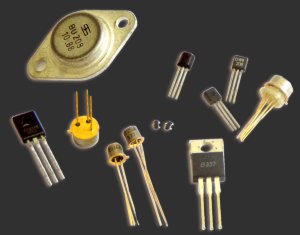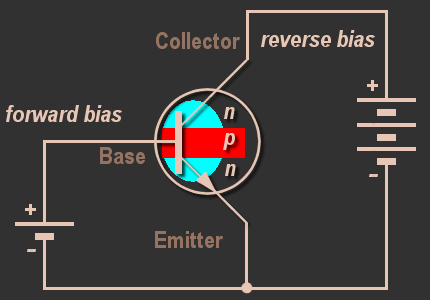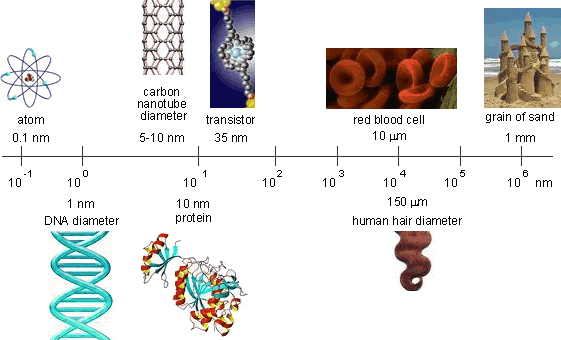
NANOTECHNOLOGY
WHAT IS A TRANSISTOR ?
The transistor is a solid state semiconductor device used for amplification and switching. It acts as a variable valve which, based on its input current (BJT) or input voltage (FET), allows a precise amount of current to flow through it from the circuit's voltage supply.
In essence, it has three terminals. A current or voltage applied through/across two terminals controls a larger current through the other terminal and the common terminal. The term transistor was originally coined from the word trans-resistance.
In analog circuits, transistors are used in amplifiers. Analog circuits include audio amplifiers, stabilized power supplies and radio frequency amplifiers. In digital circuits, transistors function essentially as electrical switches. Digital circuits include logic gates, RAM (random access memory) and microprocessors.
The transistor is a solid state semiconductor device used for amplification and switching. It acts as a variable valve which, based on its input current (BJT) or input voltage (FET), allows a precise amount of current to flow through it from the circuit's voltage supply.
In essence, it has three terminals. A current or voltage applied through/across two terminals controls a larger current through the other terminal and the common terminal. The term transistor was originally coined from the word trans-resistance.
In analog circuits, transistors are used in amplifiers. Analog circuits include audio amplifiers, stabilized power supplies and radio frequency amplifiers. In digital circuits, transistors function essentially as electrical switches. Digital circuits include logic gates, RAM (random access memory) and microprocessors.
Working of a Transistor
There are two basic types of transistors, the bipolar junction transistor (BJT) and the field-effect transistor (FET), which work differently.
Bipolar transistors are so named because the main conduction channel uses both electrons and holes to carry the main electric current.
Field-effect transistors (also called unipolar ransistors) use only one of the two types of carrier (either electrons or holes, depending on the subtype of the FET).
A voltage or current applied to one pair of the transistor's terminals changes the current flowing through another pair of terminals. Because the controlled current can be much larger than the controlling current, Thus the transistor provides amplification of a signal.
There are two basic types of transistors, the bipolar junction transistor (BJT) and the field-effect transistor (FET), which work differently.
Bipolar transistors are so named because the main conduction channel uses both electrons and holes to carry the main electric current.
Field-effect transistors (also called unipolar ransistors) use only one of the two types of carrier (either electrons or holes, depending on the subtype of the FET).
A voltage or current applied to one pair of the transistor's terminals changes the current flowing through another pair of terminals. Because the controlled current can be much larger than the controlling current, Thus the transistor provides amplification of a signal.
Key Facts about Transistors
1. There are more than 35 different kinds of transistor.
2. Before the term transistor was coined, it was called the 'three electrode circuit element'.
3. There are 8 categories of transistors.
4. There are billions of transistors in a microprocessor.
After the invention of silicon transistors, the field of electronics has simply taken off. The advent of transistors has given great impetus to the understanding of science and electronics. So we must put good effort in answering the question, how do transistors work. Many scientists consider the invention of transistor as the biggest discovery in the field of electronics in the last century.
1. There are more than 35 different kinds of transistor.
2. Before the term transistor was coined, it was called the 'three electrode circuit element'.
3. There are 8 categories of transistors.
4. There are billions of transistors in a microprocessor.
After the invention of silicon transistors, the field of electronics has simply taken off. The advent of transistors has given great impetus to the understanding of science and electronics. So we must put good effort in answering the question, how do transistors work. Many scientists consider the invention of transistor as the biggest discovery in the field of electronics in the last century.
Nanotechnology is the hybrid science combining engineering and chemistry that have applications in the real world. The area of nanotechnology lets one build elaborate structures, atom by atom, on a scale of 1 to 100 nanometers that can store information, switch electrical signals, convert sunlight to electricity.
A nanometer is a billionth of a meter that is about 1/80,000 of the diameter of a human hair, or 10 times the diameter of a hydrogen atom. In this paper we had dealt with the main concepts involved in the field of nanotechnology which are as follows:
1. Bio-Computing
2. Molecular Computing
3. Quantum Computing
4. Optical Computing
A nanometer is a billionth of a meter that is about 1/80,000 of the diameter of a human hair, or 10 times the diameter of a hydrogen atom. In this paper we had dealt with the main concepts involved in the field of nanotechnology which are as follows:
1. Bio-Computing
2. Molecular Computing
3. Quantum Computing
4. Optical Computing
Atoms and molecules stick together because they have complementary shapes that lock together, or charges that attract. Just like magnets a positively charged atom will stick to a negatively charged atom. A specific product will take shape as millions of these atoms are pieced together by nanomachines.
The goal of nanotechnology is to manipulate atoms individually and place them in a pattern to produce a desired structure of small size that spreads its wings in the modern trends.
Need for Nanotechnology:
Computer process combines several million transistors to form logic gates, adders, memory in a highly ordered and complex fashion.Such devices are fabricated using planar technology whereby masks are used to define areas of
1. Electronic doping (the addition of electron donor or acceptor atoms),
2. Metallisation (the addition of conducting metal wires), or
3. Etching (the removal of unwanted material by chemical means).
Nanoelectronics refer to the use of nanotechnology on electronic components, especially transistors. Although the term nanotechnology is generally defined as utilizing technology less than 100 nm in size, nanoelectronics often refer to transistor devices that are so small that inter-atomic interactions and quantum mechanical properties need to be studied extensively. As a result, present transistors do not fall under this category, even though these devices are manufactured with 45 nm, 32 nm, or 22 nm technology.
The goal of nanotechnology is to manipulate atoms individually and place them in a pattern to produce a desired structure of small size that spreads its wings in the modern trends.
Need for Nanotechnology:
Computer process combines several million transistors to form logic gates, adders, memory in a highly ordered and complex fashion.Such devices are fabricated using planar technology whereby masks are used to define areas of
1. Electronic doping (the addition of electron donor or acceptor atoms),
2. Metallisation (the addition of conducting metal wires), or
3. Etching (the removal of unwanted material by chemical means).
Nanoelectronics refer to the use of nanotechnology on electronic components, especially transistors. Although the term nanotechnology is generally defined as utilizing technology less than 100 nm in size, nanoelectronics often refer to transistor devices that are so small that inter-atomic interactions and quantum mechanical properties need to be studied extensively. As a result, present transistors do not fall under this category, even though these devices are manufactured with 45 nm, 32 nm, or 22 nm technology.


Advantages of transistors over thermionic valves
Before the development of the transistor, the thermionic valve, or vacuum tube, was the main active component in electronic equipment. The key advantages that have allowed transistors to replace their valve predecessors in almost all applications are:
1. Smaller size (despite continuing miniaturization of tubes)
2. Highly automated manufacture
3. Lower cost (in volume production)
4. Lower operating voltage
5. Absence of a heater
6. Lower power dissipation (no heater and very low saturation voltage)
7. Higher reliability and greater endurance
8. Availability of complementary devices (allowing circuits with complementary symmetry (complementary versions of valves are not available)
9. Ability to control large currents (power transistors are available to control hundreds of amperes, while a valve to control even one ampere is quite large and expensive)
Before the development of the transistor, the thermionic valve, or vacuum tube, was the main active component in electronic equipment. The key advantages that have allowed transistors to replace their valve predecessors in almost all applications are:
1. Smaller size (despite continuing miniaturization of tubes)
2. Highly automated manufacture
3. Lower cost (in volume production)
4. Lower operating voltage
5. Absence of a heater
6. Lower power dissipation (no heater and very low saturation voltage)
7. Higher reliability and greater endurance
8. Availability of complementary devices (allowing circuits with complementary symmetry (complementary versions of valves are not available)
9. Ability to control large currents (power transistors are available to control hundreds of amperes, while a valve to control even one ampere is quite large and expensive)

When matter has at least one dimension between 1 – 100 nm new and very useful properties emerge. On these length scales, quantum mechanics describes the properties of matter.